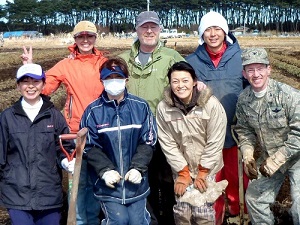From "Faculty Matters" Summer 2011 Issue, by Carlye Malchuk Dash
High atop a bluff, Brent Duncan and his wife Penny watched as the Pacific Ocean overpowered the shoreline and blanketed communities along the northeastern coast of Japan. As surge after surge of water rushed inland, Duncan, a lead faculty member with the University of Phoenix, knew the low-lying areas would be badly damaged.
When the devastating earthquake and resulting tsunami finally ran their course, hundreds of miles of Japan’s coastline lay devastated and tens of thousands of people were dead or missing.
Those numbers don’t even begin to touch on the loss of family, property, and history. “The people in the rural areas where we live, these are people whose families have had the same occupation on the same pieces of land for hundreds and hundreds of years,” explains Duncan.
He is a member of the University’s Asia/Pacific Military Division which is based out of the Misawa Air Base on the northern tip of Japan. “They’ve lost not only their homes but also their livelihoods. They’ve lost their culture and they’ve lost those areas that are sacred to them.”
Digging out
In the days and weeks following the March 11 earthquake and tsunami, Duncan has devoted his time to helping dig out these communities. “Boats were brought a quarter-mile inland and we are having to clean out miles and miles of netting with all the rotten fish and everything in it,” he says. He has met many other volunteers in his travels, including civilians, Air Force, Navy, and Marine personnel.
Survivors’ anguish

As cleanup efforts continue, Duncan has become concerned with the future of the survivors and is now networking within the communities, hoping to lend support to long-term recovery efforts. “There’s going to be a serious need for trauma relief,” he says, describing one town where the sole mental health worker is donating his time, working around the clock with survivors. Although the doctor would not say this to Duncan himself, his assistant described the work as primarily suicide prevention.
One of Duncan’s University students is a social worker who has been assigned to help elderly trauma victims in the disaster zone. “The poor guy is totally overwhelmed with people who are mourning, who are just really struggling,” Duncan explains. “What’s really sad is that he is also suffering the loss of many of his loved ones.”
Lending a hand across the miles
About 200 miles away from the worst-hit areas and sheltered from the effects of the tsunami, Jeff Gordon, a University faculty member working out of Yokosuka Naval Base, says people there are doing what they can to help those affected. “We’ve all contributed clothing, food, and money to the relief effort,” he says. “One of my faculty members arranged for 1 million gallons of freshwater to be given to the Japanese to help in cooling down the [nuclear] reactors up north [at the Fukushima Daiichi plant]. … The water was transported on U.S. Navy barges under Japanese Navy escort for the 35-hour trip up north.”
The Phoenix community

Of the six Asia/Pacific Military Program Campus locations on the main island of Japan, four were directly affected by the disaster—none more so than Misawa, recalls Barb Turner, Director of Academic Affairs for the Asia/Pacific Military Programs. “Our first and foremost concern was the safety of our faculty and students,” says Turner of the hours and days following the disaster. “Most of what we had were email and cell phones [to communicate] but most of the cell phones weren’t working so we were putting emails out and just sitting and waiting to see.”
As Turner, located off the main island in Okinawa, and her staff anxiously awaited word that faculty and students were safe, she describes the “overwhelming support” felt by those in Japan from the central office in Phoenix. “They were getting in touch with us, reacting immediately. A lot of things happened to try to take care of these students that are in crisis,” she says. “Natural disasters happen, but this was somewhat unprecedented.”
Moving forward

As weeks turn into months, the damage caused by the disaster becomes more apparent, and survivors continue with their daily struggle to clean up and rebuild. Dr. Tim W. Williams, a University faculty member at the Yokota Air Base and Camp Zama near Tokyo, says changes to work schedules and the transportation system in the nation’s capital are being made to help cope with power shortages, and serve as daily reminders of the challenges in Japan’s future. “This is not going to be over in the next day, month, or two months,” Williams says. “This is probably going to be a year, two years, three-year process to recover.”
“We still do not understand the scope of this disaster,” says Duncan. “Even when we get to the point where everybody’s fed, where everybody has electricity, and where we’re getting to a point of normality, we still have to take into consideration the spiritual welfare, the psychological welfare, the emotional welfare.”
Duncan has been keeping photographic and video diaries of the cleanup efforts. His stark images show volunteers trudging through communities that have been reduced to mounds of twisted metal and debris. In one photo, a young woman painstakingly works to restore photographs recovered from now-devastated family homes. This woman has also lost her home, Duncan explains. Each day she leaves a temporary shelter to continue her work preserving other families’ treasures. It is her hope that if she can locate the photographs’ owners, they can hold on to a piece of their past as they look toward the future.


